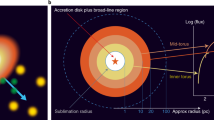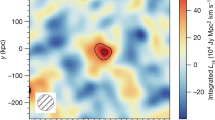Abstract
AFTER the first detection of the 616–523 transition of water vapour in an external galaxy by Churchwell et al.1 in M33, other detections were reported by Lépine and dos Santos2 in NGC253, and by Huchtmeier et al.3 in M33 and IC342. We report here the detection of H2O maser emission from NGC4945, a bright edge-on spiral galaxy in the Centaurus group. This is intrinsically the most powerful H2O maser yet detected in any astronomical source. The search for H2O emission in NGC4945 was motivated by the previous detection of OH and H2CO absorption by Whiteoak and Gardner4 and Gardner and Whiteoak5, and also by the similarity of this galaxy to NGC253. The observations were made on 20–22 September 1978, with the 13.7-m Itapetinga radiotelescope equipped with a ruby maser amplifier with an apparent SSB system temperature of about 150 K. The signal was analysed by a 46-channel, 100–kHz (1.35 km s−1) resolution filter bank, and observations were made with the filter bank centred at different frequencies to obtain greater velocity coverage. The 4′ beam was pointed towards the nucleus of the galaxy. The overall dimensions of the galaxy are 17′ × 3′. The telescope was beam switched at a rate of 100 Hz. The beams were separated by 9.4 arc min and the reference beam was displaced in azimuth, which did not correspond to a fixed direction with respect to the equatorial plane of NGC4945. Antenna temperatures were corrected for atmospheric attenuation and random attenuation using the standard procedure at Itapetinga6 and then converted to flux units, the error in the flux scale being ∼10%.
This is a preview of subscription content, access via your institution
Access options
Subscribe to this journal
Receive 51 print issues and online access
$199.00 per year
only $3.90 per issue
Buy this article
- Purchase on Springer Link
- Instant access to full article PDF
Prices may be subject to local taxes which are calculated during checkout
Similar content being viewed by others
References
Churchwell, E. et al. Astr. Astrophys. 54, 969 (1977).
Lépine, J. R. D. & dos Santos, P. M. Nature 270, 501 (1977).
Huchtmeier, W. K. et al. Astr. Astrophys. 64, 21 (1978).
Whiteoak, J. B. & Gardner, F. F. Astrophys. J. Lett. 195, 81 (1975).
Gardner, F. F. & Whiteoak, J. B. Nature 247, 526 (1974).
Kaufmann, P., Zisk, S., Scalise, Jr., E., Schaal, R. E. & Gammon, R. H. Astr. J. 82, 577 (1977).
Allen, C. W. Astrophysical Quantities, 3rd edn, (Athlone, London, 1973).
Whiteoak, J. B. & Gardner, F. F. Proc. Astr. Soc. Aust. 3, 71 (1976).
Shobbrook, R. R. & Shaver, P. A. Observatory 87, 169 (1967).
Author information
Authors and Affiliations
Rights and permissions
About this article
Cite this article
DOS SANTOS, P., LÉPINE, J. Detection of strong H2O emission from galaxy NGC4945. Nature 278, 34–35 (1979). https://doi.org/10.1038/278034a0
Received:
Accepted:
Published:
Issue Date:
DOI: https://doi.org/10.1038/278034a0
This article is cited by
-
Astronomical Distance Determination in the Space Age
Space Science Reviews (2018)
-
SiO and CH3OH mega-masers in NGC 1068
Nature Communications (2014)
-
On the prescriptions of viscosity in an accretion disk model
Astrophysics and Space Science (2012)
-
Supermassive Black Holes in Galactic Nuclei: Past, Present and Future Research
Space Science Reviews (2005)
-
High-Resolution Acta Observations of the Circumnuclear Molecular Clouds of Ngc 4945
Astrophysics and Space Science (2005)
Comments
By submitting a comment you agree to abide by our Terms and Community Guidelines. If you find something abusive or that does not comply with our terms or guidelines please flag it as inappropriate.



